| Published
on 10
Jul
2007 |
All rights reserved.
|
|
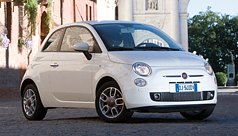 To build a good
small car these days is
not an easy task. The requirements for safety and refinement always
contradict with small size and low price. Even more difficult is to
build a good small car that looks desirable. BMW's Mini is
unquestionably very successful in this area. However, it is no longer a
small car and its price is far from bargain. The same goes for the "new
people's car" – Volkswagen New Beetle. Both Mini and Beetle are modern
remake of classic icons. Unfortunately, both lost the spirit of the
original cars and became niches selling at premium prices. If you want
to buy a really affordable small car that offers modern performance,
comfort, safety and refinement yet feeling absolutely desirable, you
must look no further than Italy. To build a good
small car these days is
not an easy task. The requirements for safety and refinement always
contradict with small size and low price. Even more difficult is to
build a good small car that looks desirable. BMW's Mini is
unquestionably very successful in this area. However, it is no longer a
small car and its price is far from bargain. The same goes for the "new
people's car" – Volkswagen New Beetle. Both Mini and Beetle are modern
remake of classic icons. Unfortunately, both lost the spirit of the
original cars and became niches selling at premium prices. If you want
to buy a really affordable small car that offers modern performance,
comfort, safety and refinement yet feeling absolutely desirable, you
must look no further than Italy.
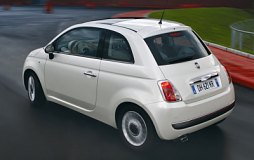 Fiat has a rich history of building the world's best small
cars – just a check with my classic car archives and you'll find famous
nameplates like 500 Topolino, 500 Nuova, 600 and Uno. The new 500 (or
"Cinquecento" in Italian) is the modern interpretation of the 500 Nuova
of 1957. From outside it has a strong visual link with the original
design, especially the egg-shape body shell, round headlights and flat
nose. Most important, it looks as cult as the old car and I'm sure
everybody will love it from first sight. Like BMW's Mini, which was
designed by the same man – Frank Stephenson, the new 500 uses a lot of
chromed decorations to deliver a premium feel. Its cabin is also full
of tasteful design and fine quality materials to lift it above ordinary
small cars. Apart from Mini, I'm afraid no other small cars could be so
visually attractive. Fiat has a rich history of building the world's best small
cars – just a check with my classic car archives and you'll find famous
nameplates like 500 Topolino, 500 Nuova, 600 and Uno. The new 500 (or
"Cinquecento" in Italian) is the modern interpretation of the 500 Nuova
of 1957. From outside it has a strong visual link with the original
design, especially the egg-shape body shell, round headlights and flat
nose. Most important, it looks as cult as the old car and I'm sure
everybody will love it from first sight. Like BMW's Mini, which was
designed by the same man – Frank Stephenson, the new 500 uses a lot of
chromed decorations to deliver a premium feel. Its cabin is also full
of tasteful design and fine quality materials to lift it above ordinary
small cars. Apart from Mini, I'm afraid no other small cars could be so
visually attractive.
However, what lift it above Mini is packaging. The 500 is very compact
– some 153mm shorter and 56mm narrower than the Mini. It weighs
considerably less, too – the 1.2-liter car and 1.4-liter car tip the
scale at 865 kg and 930 kg respectively, some 195 kg and 130 kg lighter
than the basic Mini One ! Its drag coefficient of 0.325 is also a
little better than the Mini. These factors translate to better fuel
economy, greener emission and lower running costs. It also means you
can opt for a smaller engine to obtain the same performance.
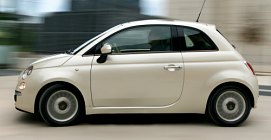 You might think the compact size and lightweight must have
some drawbacks in cabin space and safety. Not really. The cabin of 500
is actually roomier than the Mini, especially for rear seats. It can
accommodate two 6-footers behind another two 6-footers. Boot volume is
also bigger, i.e. 185 liters versus 160 liters. This is a cleverly
packaged little car like the original Dante Giacosa design. As for
safety, Fiat used computer simulation to find a solution to achieve
5-star or even 6-star crash rating from a very short front overhang. It
also equips the 500 with the most extensive safety equipment in the
sub-mini class, such as 7 airbags, ESP stability control, ABS, EBD
electronic brake force distribution and ASR anti-slip control. You might think the compact size and lightweight must have
some drawbacks in cabin space and safety. Not really. The cabin of 500
is actually roomier than the Mini, especially for rear seats. It can
accommodate two 6-footers behind another two 6-footers. Boot volume is
also bigger, i.e. 185 liters versus 160 liters. This is a cleverly
packaged little car like the original Dante Giacosa design. As for
safety, Fiat used computer simulation to find a solution to achieve
5-star or even 6-star crash rating from a very short front overhang. It
also equips the 500 with the most extensive safety equipment in the
sub-mini class, such as 7 airbags, ESP stability control, ABS, EBD
electronic brake force distribution and ASR anti-slip control.
To lower development and production costs, the new 500 is derived from
the platform of Panda and built alongside it at the Tychy plant in
Poland. It shares the same wheelbase but employs wider tracks and a
lower roof to improve handling. The front overhang is shortened while
the rear overhang is lengthened a little to resemble the rear-engined
old car. Suspensions are basically the same as Panda, albeit with
revised tuning. Steering is again electrically assisted and provides a
City mode with lighter weighting for the ease of parking. 1.4-liter
Sport model provides an additional Sport button to increase steering
effort and sharpen throttle response.
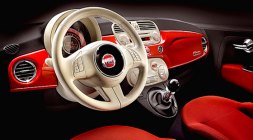 Engines are similar to the Panda, too. Base engine is the
well proven 1.2 liter FIRE 8-valve with 69 horsepower. On paper, it
seems outdated and short of power. On the road, however, it feels
refined and potent, thanks to strong bottom and mid-range torque. It is
an excellent budget engine. In the middle of the range is the famous
75hp 1.3 Multijet 16V turbo diesel engine. At this price you can hardly
find a diesel engine as gusty and refined yet delivering 67.3 mpg and
emitting only 111 g/km of carbon-dioxide. On the top of the range is a
1.4-liter FIRE 16V engine, coming from Panda 100HP. 100 horsepower, a
sporty exhaust note and a close-ratio 6-speed gearbox give it a quite
exciting character and 0-60 mph in under 10 seconds. Nevertheless, it
has no intention to be a hot hatch, because Fiat reserves that place
for the forthcoming Abarth 500, which employs a 135hp / 150hp 1.4T-JET
turbo 16V engine. We can't wait for the Abarth model... Engines are similar to the Panda, too. Base engine is the
well proven 1.2 liter FIRE 8-valve with 69 horsepower. On paper, it
seems outdated and short of power. On the road, however, it feels
refined and potent, thanks to strong bottom and mid-range torque. It is
an excellent budget engine. In the middle of the range is the famous
75hp 1.3 Multijet 16V turbo diesel engine. At this price you can hardly
find a diesel engine as gusty and refined yet delivering 67.3 mpg and
emitting only 111 g/km of carbon-dioxide. On the top of the range is a
1.4-liter FIRE 16V engine, coming from Panda 100HP. 100 horsepower, a
sporty exhaust note and a close-ratio 6-speed gearbox give it a quite
exciting character and 0-60 mph in under 10 seconds. Nevertheless, it
has no intention to be a hot hatch, because Fiat reserves that place
for the forthcoming Abarth 500, which employs a 135hp / 150hp 1.4T-JET
turbo 16V engine. We can't wait for the Abarth model...
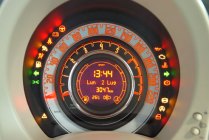 On the road, the little 500 feels lively and nimble. Its
good engines, slick gearchange and light clutch contribute to an
enjoyable driving. The small size, tight turning circle and excellent
visibility make it so easy to drive in the city. Like Panda on which it
is based, it rides very well, too. Push it harder in corners, its
handling doesn't distort. It provides bags of grip and the chassis is
remarkably neutral yet predictable at the limit. Ultimately, it can't
match Mini in the eyes of keen drivers because it has more body roll
and the steering is neither as quick nor as weighty. However, both
cars' electrical power steering are not renowned for road feel. On the road, the little 500 feels lively and nimble. Its
good engines, slick gearchange and light clutch contribute to an
enjoyable driving. The small size, tight turning circle and excellent
visibility make it so easy to drive in the city. Like Panda on which it
is based, it rides very well, too. Push it harder in corners, its
handling doesn't distort. It provides bags of grip and the chassis is
remarkably neutral yet predictable at the limit. Ultimately, it can't
match Mini in the eyes of keen drivers because it has more body roll
and the steering is neither as quick nor as weighty. However, both
cars' electrical power steering are not renowned for road feel.
That said, the new 500 scores very high marks in driving, comfort,
practicality and, most important, desirability. Moreover, it is also
highly affordable, if not as cheap as Panda. This is the best sub-mini
for years. It proves that Fiat is still the leader of small cars, even
50 years after the original 500. |
Verdict:      |
| Published
on 25
Jun
2008 |
All rights reserved.
|
|
500 Abarth
|
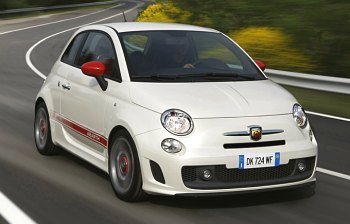 |
We didn't expect the egg-shape 500
could look so sporty...
|
We
like the new Fiat 500 very much. It is an exceptional combination of
style, quality, practicality and affordability. What it hasn’t shined
yet is performance. Any successful supermini should provide a good
performance derivative, or what we usually call “hot hatch”. BMW’s Mini
has Cooper S, Peugeot has 207GT or RC, Renault has Clio RS and (later
on) Twingo RS… They earn good money for their makers and lift the image
of lesser models. At Fiat, the moniker “Abarth” is used for that task.
Abarth is a very valuable heritage to Fiat. It has a glorious racing
history during the 1950s and 1960s. Its image was associated with some
really successful Fiat road-race cars. Using the marque carefully could
benefit the new generation fast Fiats, as we have seen in Grande Punto
Abarth. Now the Abarth conversion is expanded to the little 500.
Like its bigger brother, the 500 Abarth gets some tasteful cosmetic
enhancement. The front bumper incorporates a big air intake to feed the
intercooler and a couple of outlets to release the hot air. Deep air
splitter and side skirts improve aerodynamics. Ditto the new rear
bumper with integral diffusers and exhaust pipe at either side. We
don’t know how much benefit the short diffuser brings at its maximum
127 mph top speed, but it certainly enhances the look. As in Grande
Punto Abarth, you will find a pair of red door mirrors and Abarth red
racing stripes graphics at either side. Finally, a set of very stylish
alloy wheels complete the conversion. Well done ! We didn’t expect the
egg-shape 500 could be made so sporty.
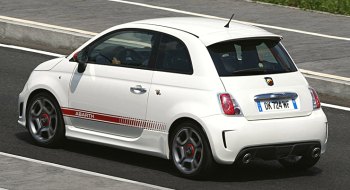
|
At this price segment its performance
is virtually unbeatable...
|
Its
engine is
a
detuned version of its bigger brother’s 1.4-liter DOHC 16V turbocharged
unit. Power is scaled back from 155 hp to a still respectable 135 hp.
Maximum torque is 138 lb-ft at 2500 rpm or, if you turn on the Sport
mode, 152 lb-ft at 3000 rpm. Compare with the naturally aspirated
Renault Twingo RS (133 hp / 118 lbft) and Mini Cooper (120 hp / 118
lbft) – both are its closest rivals in terms of price and market
positioning – the Fiat’s superior turbocharged torque delivers
significantly stronger performance. It accelerates from 0-60 mph in
merely 7.5 seconds, while its rivals take about 1 second longer. The
good temper of this turbocharged engine means excellent everyday
usability. Its brisk performance is easily accessible. Ultimately,
Fiat’s 1.4 turbo engine is not as sweet as the 1.6 turbo unit of Mini
Cooper S, but at this price segment it is virtually unbeatable !
In the cabin, the Abarth enhancement include bucket seats, a
flat-bottomed steering wheel, alloy pedals, a turbo boost gauge and
some leather trims. The driver seat is still mounted too high, but that
is necessary because of the high shoulder line. Rear legroom becomes
tighter due to the thicker front seats.
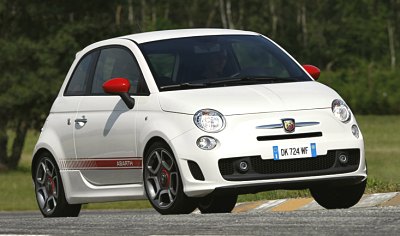
|
Fun to drive up to 80 to 90 percent
effort...
|
The
Abarth’s
suspensions are stiffer and 15mm lower than the standard 500. Rear
anti-roll bar has been added. It employs larger brakes made by Brembo,
larger alloy wheels (16-inch standard and 17-inch optional) and wider
tires (195/45 standard and 205/40 optional). Like the recent Lancia
Delta and Mini John Cooper Works, it employs a Torque Transfer Control
(TTC) system which applies soft braking on the spinning inside front
wheel to transfer more torque to the outside front wheel. This
enhance grip
and reduce understeer in tight corners, thus greatly enhance its
maneuverability on twisty roads.
On the road, the 500 Abarth is a competent hot hatch. It has
plenty of pulling power but no torque steer at all. Its power is well
matched with the capability of its chassis. The
little car is quite agile, if not as sharp as
Mini Cooper. Its tall body is
subjected to some roll, at least this is how you feel from the
high-mounted driving seat. It runs into safe understeer near the limit
and back off won’t change much its attitude. However, in the twisty it
handles fluently
thanks to good grip, excellent braking and the aforementioned TTC. You
might not be pleased with its artificial feeling electric power
steering, but frankly, fewer and fewer hot hatches these days inspire
their drivers with communicative steering.
The 500 Abarth is fun to drive up to 80-90 percent effort. Above that
threshold it will be no match with Mini Cooper. However, taking its
strong performance, desirable packaging and keen pricing into
consideration, it could be the most attractive choice in its price
segment.
|
Verdict:     |
Published
on 21
May 2009
|
All rights reserved.
|
|
500 Abarth SS
|
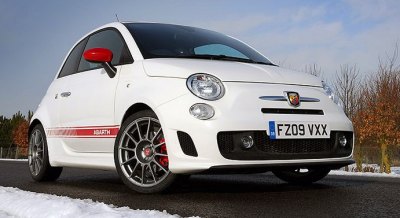
|
Sportier and rawer, but equally
desirable.
|
To
most people, Fiat 500 Abarth hits the sweet spot between driving fun
and practicality. However, if you prepare to sacrifice some comfort for
more excitement, you can opt for the £2,500 Esseesse (SS)
package. This package brings a list of upgrade: 17-inch alloy wheels,
stiffer suspension setup, 5 mm lower ride height, cross-drilled brake
discs and upgraded pads. Besides, the 1.4-liter turbo engine gets
higher boost due to revised ECU and a less restricted air filter. Max
power has increased by 25hp to
160hp, while max torque is lifted from 152 to 170 lb-ft. This allow the
SS to accelerate from rest to 60 mph in less than 7 seconds,
respectable for an egg-shape mini car.
On the road, the SS feels noticeably sportier – and rawer – than the
standard Abarth. Its engine produces stronger torque from the mid-range
and sounds more gruffy. The front rubbers grip hard while the steering
is quick and accurate, if still not communicative. Body control is
excellent thanks to the stiff suspensions. The combination of taut
handling, faithful braking and tractable engine means SS is
surprisingly fun to drive in the twisty. The only downside is a hard
ride, which could be harsh on less smooth surfaces.
Being harsher and noisier than the standard Abarth, the
SS is more suitable to hardcore drivers. Undeniably, it is neither as
entertaining as Renault Clio RS nor as all-round as Mini Cooper S.
However, that doesn't prevent it from tempting buyers away from its
rivals, especially when it looks so desirable.
|
Verdict:     |
| Published
on 5
Nov 2008 |
All rights reserved.
|
|
Derivative: Ford Ka
|
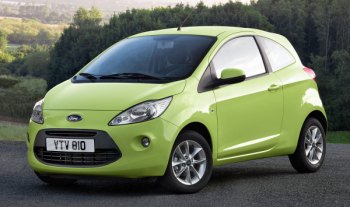
|
Calling it a joint venture may be a
little misleading. In fact, Ford Ka is a repackaged version of Fiat 500.
|
Everybody
knows A-segment small cars are difficult to turn profit. They are cheap
to sell but not necessarily cheap to build or develop. They are heavily
influenced by the rise of raw material costs and the tightening safety
and emission regulations. The only way to guarantee profitability is to
increase economy of scale through joint venture. This was why Toyota
sought PSA (Peugeot and Citroen) as its partner for the Aygo project. A
similar problem was encountered by Fiat. When it started planning the
new Fiat 500, it forecasted the demand of this niche model may not
justify its investment costs. Therefore it needed a partner to share
costs. At the time, Ford of Europe was hesitating on the replacement of
its Ka because it could also cost too much money to develop than it
could earn. Common interests brought the two European rivals together.
They agreed on a joint venture to produce the 500 and Ka as twins.
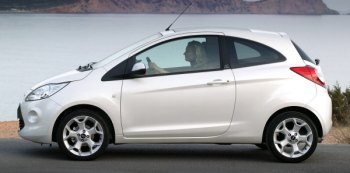
|
The baby Ford has enough character to
distinguish itself from Fiat...
|
Calling
it a
joint
venture may be a little misleading. In fact, Ford Ka is a "customer
project" implemented by Fiat. It is basically a repackaged version of
the 500. Production also takes place at Fiat's Tichy plant in Poland,
alongside the 500 and Panda. In principle, the plant can produce at
most 120,000 units of 500 and 120,000 units of Ka a year.
The Ka shares the same hard points position with the Fiat. Wheelbase is
therefore the same 2300 mm, although it has longer front and rear
overhangs. Mechanicals are also carried over from the Fiat, albeit with
fewer choices of engines (only 1.2-liter 8V 69hp and 1.3 turbo diesel
75hp) and only one transmission (5-speed manual). There is no plan for
a hot hatch model like Abarth, perhaps because Fiat wants to reserve
the best for itself.
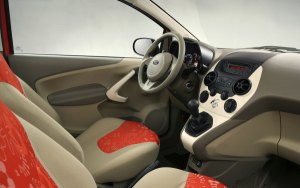
|
On looks and quality, Ka is by no
means as desirable as 500. Contrast to this is dynamics...
|
However,
the
baby
Ford has enough character to distinguish itself from Fiat. This is
because it was styled and tuned by Ford. Its exterior design is sporty
and resembles the new Fiesta. Its interior, though sharing the same
basic architecture with 500, has a very different design. While 500
sells premium packaging, Ka is satisfied to be cheap and basic,
therefore you can see cheaper plastics and switch gears here.
Predictably, both cars offer good front space and decent space for
short adults at the back.
On looks and quality, Ka is by no means as desirable as 500.
Nevertheless, its bespoke suspension tuning is better done. It uses a
thicker anti-roll bar up front and adds an anti-roll bar at the rear.
This allow better roll control such that the suspension dampers could
be set 30 percent softer to improve ride quality. The electrical power
steering is also retuned to the taste of Ford. As a result, the Ka
rides, handles and steers better than its Fiat sister. That said, its
handling is not as sharp and adjustable as the old Ka.
|
Verdict:     |
Published
on 14
Jul 2010
|
All rights reserved.
|
|
500 TwinAir
|
No
matter exterior or interior, this FIAT 500 looks exactly the same as
the existing car. It has the same quality and tasteful feel that
separate the 500 from other small cars. On the move, it handles with
the same tidiness and runs with mostly the same refinement. Below 2500
rpm, the engine spins just as smooth as a regular 4-cylinder engine,
and the engine note is subdued. Squeeze more power from it, however,
you will notice a different soundtrack – more like that of a motorcycle
engine. Yes, because this is a 835cc twin-cylinder engine.
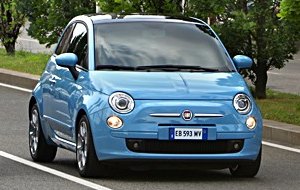
|
Below 2500 rpm, the engine spins just
as smooth as a regular 4-cylinder engine...
|
FIAT's TwinAir engine is one of the
big news of automotive
technology this year. It is a landmark statement of European Union's
pursuit of green motoring and FIAT's leading status in this field. Most
other car makers are downsizing engines in the easy way, say, from V6
to 4-cylinder turbo or from 2.0-liter to 1.4-liter turbo. Very few try
to go one step further and think beyond the bread-and-butter 4-cylinder
format. As we know Mercedes and BMW are working on 3-cylinder engines
to replace their base fours, but to the guys at FIAT Powertrain, three
is not good enough. They go straight to two-cylinder. Needless to say,
the fewer cylinders the less frictional loss and thermal loss hence the
higher energy efficiency can be attained.
You might remember FIAT had a good history of producing twin-cylinder
engines for the old 500 and 126. They were chosen for low cost rather
than any other reasons. The same cannot be said to the new engine. It
is designed to deliver incredibly low emission and fuel consumption, so
it packs a lot of advanced technology that other bread-and-butter
engines cannot dream of, such as automatic start-stop, 4 valves per
cylinder and Multiair
electrohydraulic variable valve actuation. Three states of tune will be
offered – 65hp, 85hp and 105hp, with the last two being turbocharged.
The one making debut in the aforementioned FIAT 500 is the 85hp
light-pressure turbo unit. Its output slots between the existing 1.2 8V
(69hp) and 1.4 16V (100hp) four-cylinder, but it delivers a remarkable
107 pound-foot of torque, 10 lb-ft more than the 1.4. Moreover, that
peak torque is available from only 1900 rpm (at the same rev, the 1.4
unit delivers only 85 lb-ft). This explain why FIAT claims the same
0-60 mph time despite of its 15hp disadvantage at higher rev.
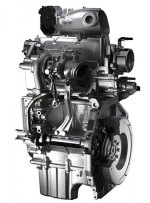
|
Same real-world performance as the 1.4
16V but 30 percent greener
|
On the road, the 500 TwinAir does not
feel slower than 1.4 under normal driving. Instead, its stronger
low-end grunt makes it feel a touch more lively around town. Turbo lag
is all but non-existent thanks to the small turbine and mild charge.
Refinement is surprisingly good. The first order vibration inherent to
twin-cylinder format is satisfactorily cancelled by a balancer shaft
located adjacent to the crankcase. Only at idle there is a little bit
vibration like diesel engines. Noise insulation around the engine and
the cabin of 500 effectively filters out the odd twin-cylinder note
until you stretch the engine above 3000 rpm, thereafter the motorcycle
note becomes more pronounced. It takes some getting used to. If you
regularly drive the car on highway, the four-cylinder 1.4 will be a
better choice.
If your route is normally bounded in urban area, the TwinAir will be
more appealing. That appeal does not come from the price tag, because
the technology-packed engine costs nearly the same as the 1.4. Instead,
it comes from the 69 mpg combined consumption and 95g/km CO2
emission, i.e. 30 percent lower than the 1.4 ! Even compare with the
much slower 1.2 8V, it is some 15 percent greener. While it is no
cheaper to purchase, it guarantees lower tax and running costs, and by
the way makes you feel less guilty for polluting the earth. |
Verdict:     |
| Published
on 26
Jul
2013 |
All rights reserved.
|
|
500e
|
|
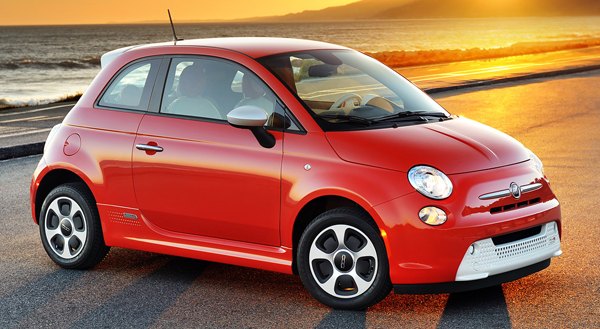
|
Fiat boss Sergio Marchionne
said his company builds the Fiat 500e electric car just to satisfy the
ZEV requirement of California. Although Fiat does not fall into the
scope (as it exports too few cars to California thus is not qualified
to be "large and intermediate auto makers"), its subsidiary Chrysler
does. Therefore the 500e is sold under Chrysler LLC. Being sold at
$22,500 after the federal grant of $7500 and California rebate of
$2500, it is not too expensive for a funky premium EV. However,
Marchionne complained that he will lose $10,000 on every car sold. A
cruel fact: EV technology is still too expensive to be competitive.
The 500e is easy to win hearts with its retro yet funky look.
Thankfully, it doesn't differ much from the standard car, which is so
pretty that you won't believe it is already 6 years old. The white
lower front grille – with a large portion of the mesh sealed as the
electrical system needs less cooling – is the only major difference.
Minor ones include the new wheel design and extra aero kits that come
mostly from the Abarth model. Further aided by a smooth underbody and
smoother side mirrors, its drag coefficient drops from 0.33 to 0.311.
This alone adds an extra range of 5 miles.
The whole electrical system is provided by Bosch. Its 24 kWh
lithium-ion battery is relatively large for the class, resulting in a
class-leading range of 87 miles (140 km). This pack weighs a massive
290 kg, but it is placed right at the floorpan level and between the
side rails, lowering center of gravity considerably and improving
front-to-rear weight distribution to 57:43 (versus the regular car's
64:36). On the downside, the battery reduces rear legroom considerably.
Nevertheless, this is probably not a headache to most buyers, as the
rear seat of the 500 is rarely used to hold human being anyway. If you
want 4-seat accommodation, a Chevy Spark EV or Nissan Leaf would be
better options.
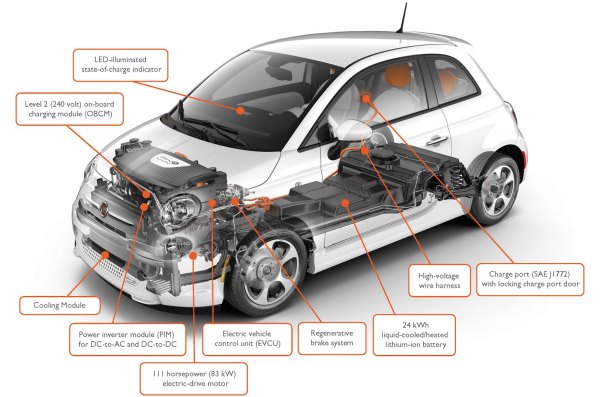
|
The front wheels are driven by a 3-phase synchronous motor
through a single-speed gearbox. With 111 horsepower and 147 pound-foot
of torque from just over zero rpm, the 500e drives a lot like a turbo
diesel except that it does the job in complete silence. It sprints from
0-60 mph in less than 9 seconds, a full second quicker than the regular
500 1.4 16V, yet the advantage is even stronger at 30 or 40 mph.
However, it cannot match turbo diesel on highway, where its power fades
out with speed and the speed limiter intervenes at 85 mph. After all,
EVs are very much city cars.
Despite of the extra weight, the 500e drives very much like the
conventional 500s. The effect of extra weight is offset by the optimum
weight distribution and stiffer suspension. It remains a nimble car to
steer and to place. Grip is reduced a little, partly blame to the
low-rolling resistance tires, but should not be a problem for a car
without sporting pretension. Ride quality is a little choppy on rough
surfaces like the regular car, but the quiet motor, the 10-percent
stiffer floorpan and enhanced sound deadening improve aural refinement
a lot. Most successful is the brake feel. Bosch's system has the
regenerative braking always present at speed over 8 mph, so there is no
abrupt transition between regenerative and frictional braking. Overall,
the car is at least as much fun to drive as the lesser 500. If
anything, its extra punch makes it even more enjoyable to drive in
city.
Taking into account the superior styling, image and interior, the 500e
is clearly the most desirable EV on the market to date. From this point
of view, its purchase price is by no means expensive. Just don't forget
Fiat and US tax payers subsidize you $20K.
|
Verdict:     |
| Published
on 12
Jun
2016 |
All rights reserved.
|
|
Abarth 595 and 695
|
|
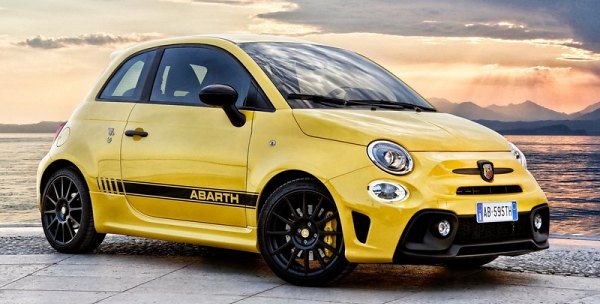 Abarth 595
Competizione Abarth 595
Competizione |
Abarth is an unfamiliar
brand outside Italy. For so long, Abarth had been closely associating
with the classic Fiat 500. It
converted the tiny Fiat to race cars with great success, most notably
the Abarth 595 (1963) and 695 (1964), which were named after their
engine displacement. So successful that Fiat simply acquired the
company in 1971 and turned it to its motorsport division. It went on to
win WRC titles with Abarth 124
Rally and Abarth 131, then Fiat
decided it had enough success, withdrew from motorsport and shut down
the division altogether, sadly – Abarth became the casualty
of its own success!
The Abarth name was resurrected only a few years ago when Fiat created
the hotter Grande Punto Abarth and 500 Abarth. Under the ever-changing
strategy of Fiat Chrysler, it is now a standalone brand. It is not
exactly a full car manufacturer like AMG, which recently earned the
status by producing its own GT. FCA has yet to approve any dedicated
Abarth models. All it wants the performance brand to do is to modify
the mainstream Fiat cars into hotter variants, just like what Abarth
used to in its golden years. Naturally, Fiat 500 is the very first
choice for its basis.
The new Abarth line of 500-based models consists of 595, 595 Turismo
and 595 Competizione. All of them are powered by the familiar 1.4 T-Jet
turbo engine (not the MultiAir unit of the US-market 500 Abarth, as the
twin-cam engine has more room for tuning), but they have different
states of tune to produce 145 hp, 165 hp and 180 hp respectively. The
first two apparently replaces the outgoing 500 Abarth and Abarth SS.
What catches our attention is the hottest Competizione, because as
suggested by its name, it really offers some racing ingredients, such
as a mechanical LSD (optional), 305mm Brembo front brakes, sport
exhaust, Sabelt carbon-fiber bucket seats and Koni FSD frequency
selective front dampers. You can also trim the cabin with carbon-fiber
inserts to look cool. However, with all these options ticked the car
will end up at the same price point as a 350-hp Ford Focus RS or
Volkswagen Golf R. Does the driving experience live up to expectation?
Of course not! First of all, the 595 Competizione is not that quick.
Although it is pretty light at 1070 kg, 180 horsepower is really
nothing these days (a Mini JCW has 231 hp). Moreover, its power
delivery is not as responsive as the best small turbocharged engines
simply because the T-Jet is an old design. It has more lag low down and
feels more boosty in the mid-range. It is capable to do 0-60 mph in 6.4
seconds, whereas Golf R takes 4.9. Top speed is wildly claimed to be
143 mph, but the figures coming from this Italy group is not always
credible. 180 horsepower, a large frontal area and not so sleek shape…
the math just doesn’t work out!
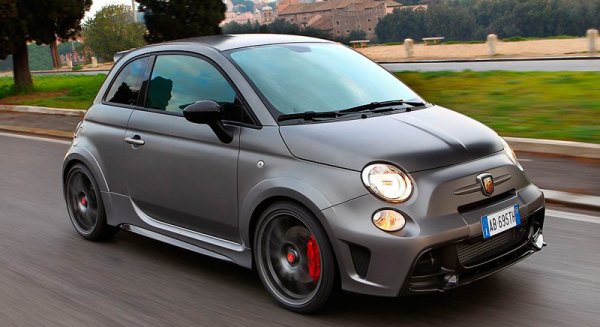 Abarth 695
Biposto
Abarth 695
Biposto |
The 500’s short wheelbase, tallness and narrow tracks mean the 595
Competizione has to ride on very stiff springs to counter body roll and
pitch. Although the FSD dampers help, the ride is still too hard by any
road car standards. The chassis is set to understeer moderately when
approaching fast corners, something understandable as the
short-wheelbase chassis is prone to oversteer abruptly when the rear
wheels break lose. At slower pace, however, the car is very nimble and
chuckable, thanks to its compact size, grippy tires and tight body
control. The steering is generally accurate but delivers little feel.
It is also mounted too upright, whereas the driving position is
truck-like – both problems are inherited from the standard Fiat.
All these mean the 595 Competizione is not going to be as fun to drive
as a Ford Fiesta ST or as well-rounded as Mini Cooper S. It looks and
feels more special, but that doesn’t outweigh its flaws and high price.
Similar comments can be said to the even racier Abarth 695 Biposto
which was launched in early 2015. “Biposto” means 2 seats, implying the
lack of rear seats. They are replaced with chassis-reinforcing tubular
braces and a parcel net. The carbon-fiber racing seats have their
4-point harnesses attached to the braces. The interior is stripped of
door panels, air-con and audio, too. Abarth quoted a dry weight of 997
kg, which should be a few dozen kilos lighter than the 595 Competizione
with which it shares the LSD and Brembo brakes. In addition, the
Biposto gets Akrapovic titanium exhaust, 18-inch wheels shod with
215/35 rubbers and Extreme Shox adjustable dampers. The engine gets a
larger Garrett turbocharger and intercooler to add another 10
horsepower to 190. With a 0-60 mph time quoted as 5.6 seconds, this
should be the fastest Fiat 500 of all. Nevertheless, it also comes with
heavier turbo lag.
As expected, this “mini supercar” is even more expensive. Its starting
price already exceeds the Golf R. With all options checked, including
racing pack, carbon interior trims, aluminum bonnet and a dog-clutch
racing gearbox, it tops out £50,000. That’s Porsche 718 Cayman S
money!
Charging more and pretending to be luxury goods, is this the future of
fast small Fiats? I’m really puzzled.
|
Verdict:    |
Published
on 13
Feb 2020
|
All rights reserved.
|
|
500 Hybrid
|
|
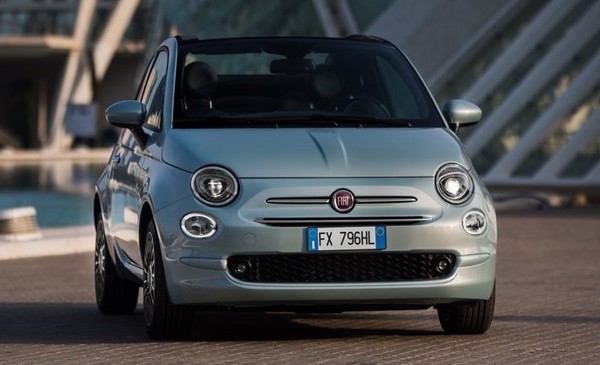
|
|
A
new 3-cylinder engine and mild-hybrid system seem to cheat EU
regulations rather than delivering real efficiency gain...
|
|
It is hard to imagine a
car born in 2007 is still soldiering on. Even more incredible is that
it looks just as fresh and cute as 13 years ago. Thanks Frank
Stephenson for creating such a timeless icon.
However, in the mechanical side, the Fiat 500 got outdated long ago.
Its tall and short proportion results in poorer dynamics and refinement
than most other small city cars. Its flawed, Italian-style ergonomics
have never been sorted. Under the bonnet, its engines are also
outdated. The TwinAir engine loses appeal when rivals introduced more
refined (and probably more economical) three-cylinder engines. Its
1.2-liter 8-valve Fire engine is older still, should have been retired
in the last century. Somehow, the late Sergio Marchionne invested all
money
into America, Maserati and Alfa Romeo, leaving the Fiat brand cold and
dying. If not the magic of Frank Stephenson, the 500 would have been
died already.
So why is Fiat finally giving the 500 a new engine? I suppose that is
driven by the new CO2 emission
regulations being
effective in EU this year. Under the new regulations, car makers
failing to meet the emission target (roughly 95 g/km, but adjusted
according to kerb weight) will be fined heavily. The old 1.2-liter Fire
emitted 108 g/km on the 500. To avoid penalty, Fiat needs a more
efficient engine, but it
doesn’t want to invest too much, so it takes the 1-liter three-cylinder
“Flyfire” engine from its Brazilian Uno. Flyfire is actually a family
of modular engines. While the most sophisticated members of it feature
4 cylinders, 16-valve head, direct injection, a turbo and MultiAir
variable valve control (they are used on Fiat 500X and Jeep Renegade),
the one goes under the bonnet of 500 is the leanest, cheapest version.
It has 3 cylinders, a single overhead camshaft running old-school 2
valves per cylinder, although the camshaft features congtinuous
variable phasing. Conventional port injection keeps cost down as well.
To enhance thermal efficiency, it uses high-tumble intake ducts and
external exhaust gas recirculation (EGR) to enable a high, 12.0:1
compression ratio without risking knock. It produces 71 hp at 6000 rpm,
marginally more than the 1.2-liter Fire, which is good. However, the
smaller capacity means torque is inevitably reduced, dropping from 75
to 69 lbft, which is produced at 3500 rpm. On the plus side, the
Flyfire has aluminum head and block to keep weight down.
Further efficiency gain comes from
a low-cost 12V belt-driven starter generator, which provides
another 5 hp to assist acceleration, or allow the engine to be shut
down during low-speed coasting. Yes, this is a mild hybrid system, like
what Suzuki has been offering for a few years. It is by no means
high-tech
or groundbreaking, but it does help the 500 Hybrid – a misleading name
– to achieve 88 g/km, a reduction of almost 20 percent.
In the real world, the 500 Hybrid isn’t too slow, but you need to rev
the engine quite hard to deliver the necessary performance. Moreover,
by doing so it gets noisy. It fails to match the 1-liter triple of
Volkswagen Up in both refinement and performance, which is no surprise
considering its simpler design and its Brazilian roots. The new 6-speed
manual gearbox pairs with the triple works reasonably well, but to
access coasting mode you need to engage neutral by yourself. There is
an indicating light on the instrument to remind you when to shift to
neutral, but it feels strange, more annoying than involving. Overall,
the new powertrain combo feels like a trick to cheat the EU regulations
rather than delivering real efficiency gain.
The rest of the 500 remains as it has always been. It falls short of
the class norm now, but given a look so irresistible, who minds the
compromises?
|
Verdict:     |
|